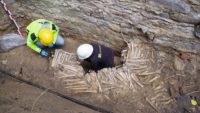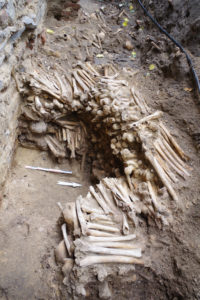 Walls made of human bones have been discovered in an excavation around Saint Bavo Cathedral in Ghent. Nine walls were found, all belonging to the same structure, consisting primarily of thigh and shin bones from adults. The gaps between the walls were filled with skulls, most of them in fragments.
Walls made of human bones have been discovered in an excavation around Saint Bavo Cathedral in Ghent. Nine walls were found, all belonging to the same structure, consisting primarily of thigh and shin bones from adults. The gaps between the walls were filled with skulls, most of them in fragments.
Constructions made from human bones are well-known at such sites as the Paris catacombs, the Sedlec Ossuary in the Czech Republic and the Capuchin Crypt under Santa Maria della Concezione in Rome. This is the first organized bone structure ever discovered in Flanders. Exhumed bones have been found from medieval cemeteries, kept in small ossuaries often built against church walls, but they were simply stored there, not carefully selected bones stacked and arranged as sound building material.
Bones were regularly cleared from city cemeteries because space was at a premium. Due to beliefs of the resurrection of the flesh, the bones could not be discarded. At least not all of them. The long bones of the limbs and skulls were preserved while the small bones — adult vertebrae, ribs, phalanges, children’s remains etc — were frequently left behind by the clearing crew.
 The Saint Bavo walls were built after one such clearing of the cathedral’s associated cemetery, either as a result of a renovation of the church or because the cemetery was full and space needed to be made. Written records of cemetery clearance are practically non-existent. Only two partial clearances are known, one in the first half of the 16th century, the other after 1784. Radiocarbon testing revealed that the bones date to the second half of the 15th century, and pottery found with the walls date to the 17th century or the first half of the 18th. Research is ongoing to attempt to confirm a cemetery clearing from that period.
The Saint Bavo walls were built after one such clearing of the cathedral’s associated cemetery, either as a result of a renovation of the church or because the cemetery was full and space needed to be made. Written records of cemetery clearance are practically non-existent. Only two partial clearances are known, one in the first half of the 16th century, the other after 1784. Radiocarbon testing revealed that the bones date to the second half of the 15th century, and pottery found with the walls date to the 17th century or the first half of the 18th. Research is ongoing to attempt to confirm a cemetery clearing from that period.
Why the bones were made into walls remains a mystery, as is the overall purpose of the structure. Another oddity is there are no arm bones, only leg bones and the skull fill.
Saint Bavo will not become Flanders’ first osteoarchitectural tourist destination. The bones will be removed to make way for the construction of a new visitor’s center dedicated to the cathedral’s great masterpiece and international attraction, the Ghent Altarpiece, aka the Adoration of the Mystic Lamb by Jan Van Eyck.